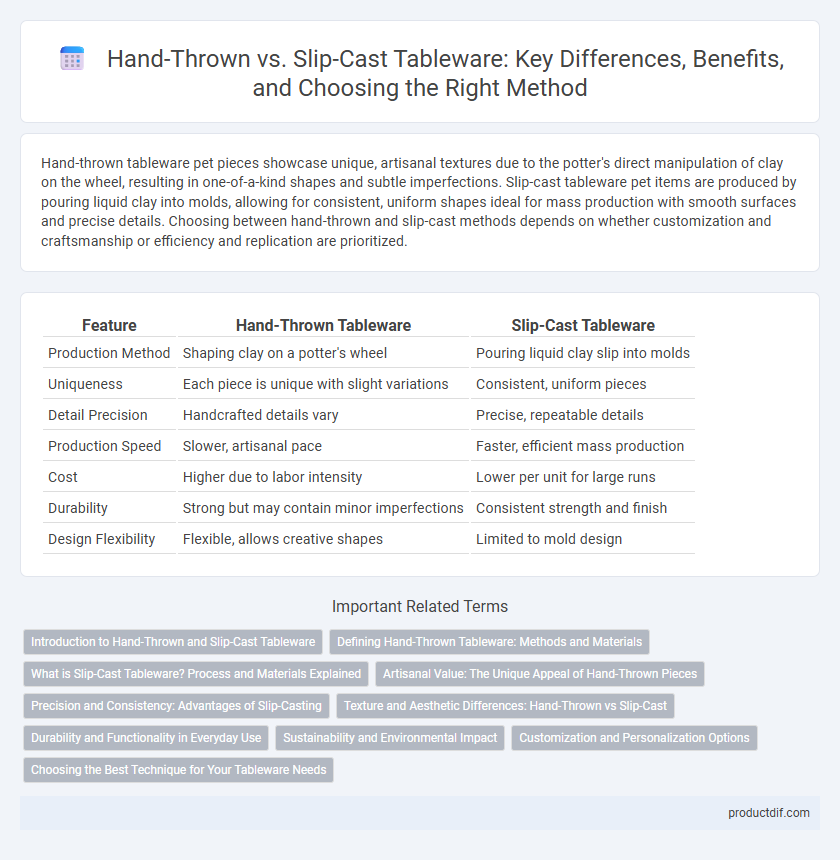Hand-thrown tableware pet pieces showcase unique, artisanal textures due to the potter's direct manipulation of clay on the wheel, resulting in one-of-a-kind shapes and subtle imperfections. Slip-cast tableware pet items are produced by pouring liquid clay into molds, allowing for consistent, uniform shapes ideal for mass production with smooth surfaces and precise details. Choosing between hand-thrown and slip-cast methods depends on whether customization and craftsmanship or efficiency and replication are prioritized.
Table of Comparison
| Feature | Hand-Thrown Tableware | Slip-Cast Tableware |
|---|---|---|
| Production Method | Shaping clay on a potter's wheel | Pouring liquid clay slip into molds |
| Uniqueness | Each piece is unique with slight variations | Consistent, uniform pieces |
| Detail Precision | Handcrafted details vary | Precise, repeatable details |
| Production Speed | Slower, artisanal pace | Faster, efficient mass production |
| Cost | Higher due to labor intensity | Lower per unit for large runs |
| Durability | Strong but may contain minor imperfections | Consistent strength and finish |
| Design Flexibility | Flexible, allows creative shapes | Limited to mold design |
Introduction to Hand-Thrown and Slip-Cast Tableware
Hand-thrown tableware is crafted on a potter's wheel, offering unique, artisanal shapes with slight variations in each piece due to manual shaping. Slip-cast tableware is produced by pouring liquid clay slip into plaster molds, enabling precise, uniform designs ideal for large-scale production. Both techniques highlight distinct craftsmanship methods, balancing individuality in hand-thrown items with consistency in slip-cast products.
Defining Hand-Thrown Tableware: Methods and Materials
Hand-thrown tableware is crafted on a potter's wheel using clay that allows for manual shaping and individual creativity, resulting in unique, artisanal pieces with subtle variations. The primary materials include stoneware or porcelain clay bodies, chosen for their workability and durability during the wheel-throwing process. Techniques emphasize the potter's skill in centering, pulling, and trimming the clay to create functional items such as bowls, mugs, and plates with organic forms and textures.
What is Slip-Cast Tableware? Process and Materials Explained
Slip-cast tableware is created by pouring liquid clay, known as slip, into plaster molds, allowing it to form a uniform, thin shell as the plaster absorbs moisture. This process enables the production of highly detailed and consistent items with smooth surfaces, ideal for mass manufacturing compared to the variability of hand-thrown pottery. Key materials include refined clay slips with controlled viscosity and plaster molds designed for rapid moisture absorption and precise shaping.
Artisanal Value: The Unique Appeal of Hand-Thrown Pieces
Hand-thrown tableware showcases exceptional artisanal value through its unique, handcrafted characteristics that highlight the potter's skill and creativity. Each piece varies slightly in shape, texture, and glaze, creating a one-of-a-kind item with intrinsic artistic appeal. Unlike slip-cast ceramics, hand-thrown pottery emphasizes individuality and the traditional craft, enhancing its desirability among collectors and connoisseurs.
Precision and Consistency: Advantages of Slip-Casting
Slip-casting offers superior precision and consistency in tableware production by using liquid clay poured into molds, ensuring uniform thickness and intricate detail replication. This method reduces variations seen in hand-thrown pottery, enabling mass production of identical pieces essential for matching dinnerware sets. Manufacturers prefer slip-casting for achieving high-quality, consistent tableware with minimal manual adjustments.
Texture and Aesthetic Differences: Hand-Thrown vs Slip-Cast
Hand-thrown tableware features unique, organic textures with subtle irregularities due to the potter's direct contact with the clay, creating a tactile and visually dynamic surface. Slip-cast pieces offer smoother, more uniform textures and precise shapes resulting from molds, which emphasize consistency and refined details. These aesthetic differences highlight handmade craftsmanship in hand-thrown ware versus the industrial precision found in slip-cast tableware.
Durability and Functionality in Everyday Use
Hand-thrown tableware, crafted by skilled artisans on a pottery wheel, typically offers enhanced durability due to its thicker walls and denser clay composition, making it ideal for everyday use and resistance to chipping. Slip-cast tableware, produced by pouring liquid clay into molds, allows for uniform shapes and thinner walls but may be more prone to breakage under heavy use, impacting long-term functionality. Choosing hand-thrown pieces ensures robust performance and longevity, while slip-cast items prioritize precision and aesthetic consistency.
Sustainability and Environmental Impact
Hand-thrown tableware typically uses traditional pottery techniques that often consume less energy and produce minimal waste compared to slip-casting, which requires molds and chemicals that may increase environmental impact. Slip-cast pieces allow for high-volume production but often rely on non-biodegradable materials and generate more industrial waste, raising sustainability concerns. Choosing hand-thrown pottery supports eco-friendly craftsmanship by minimizing resource consumption and promoting biodegradable materials.
Customization and Personalization Options
Hand-thrown tableware offers superior customization with each piece uniquely shaped by the potter's hands, allowing for personalized designs and individual imperfections that enhance character. Slip-cast tableware provides consistent, uniform shapes ideal for producing large quantities, but customization options are limited to surface decoration or glaze variations. Choosing hand-thrown pottery ensures exclusive, bespoke tableware, while slip-cast methods favor standardization with some personalization through finishing techniques.
Choosing the Best Technique for Your Tableware Needs
Hand-thrown tableware offers unique, artisanal textures and shapes, ideal for those seeking personalized and one-of-a-kind pieces that showcase craftsmanship. Slip-casting provides consistent, precise forms suitable for mass production and uniformity, ensuring efficiency in meeting large quantity demands. Choose hand-thrown methods for artistic expression and bespoke design, while slip-casting benefits commercial needs with reliable replication and faster output.
Hand-Thrown vs Slip-Cast Infographic

 productdif.com
productdif.com